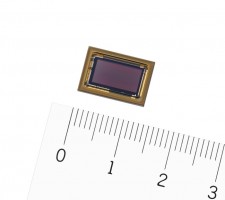Sony presents its new IMX324 CMOS image sensor designed for ADAS applications

Photo by sony
Sony announced the release of the IMX324, a new 1/1.7-type stacked CMOS image sensor equipped with the industry’s highest resolution 7.42 effective megapixel RCCC filter for forward-sensing cameras in advanced driver-assistance systems (ADAS). Sony began shipping samples in November 2017.
This image sensor is capable of approximately three times the horizontal resolution of conventional products, which enables high-definition image capture of distant road signs approximately 160 metres ahead of the camera. Furthermore, the sensor is equipped with a pixel binning mode for further raising the sensitivity in low-light environments, achieving the high sensitivity of 2666 mV, making it possible to capture images of pedestrians and obstacles even in dark situations that are equivalent to the brightness of moonlight. Even in environments with uneven, mixed levels of brightness, due to headlights and streetlights when driving at night, the sensor is equipped with a function that alternately captures dark sections at high-sensitivity settings and bright sections at high resolution, enabling high-precision image recognition when combined with the signal processing of the latter stage.
This is the first time in the industry where a stacked configuration has been employed on an automotive grade sensor. This arranges the pixel array and signal processing circuit in layers to allow for a compact size and low power consumption while still delivering high resolution.
This image sensor is expected to be compatible with the “EyeQ®4” and “EyeQ®5” image processors currently being developed by Mobileye, an Intel Company headquartered in Israel, for use in ADAS and autonomous vehicle technology.
This sensor is planned to meet the AEC-Q100 Grade 2 reliability testing standards for automotive electronic components by June 2018. Sony has also introduced a development process compliant with ISO 26262 automobile functional safety standards, to ensure design quality that satisfies the functional safety requirements for an automotive product, and this has led to its supporting functional safety requirement level ASIL B(D) for failure detection, notification, and control. Moreover, the new sensor comes with a security feature that protects the output image from being altered, which is the industry’s first application of such a function in an image sensor for automotive cameras.
Main Features
7.42 megapixels — the industry’s highest resolution for image sensors for automotive cameras
The new image sensor is capable of approximately three times the horizontal resolution of conventional products, which enables high-definition image capture of distant road signs approximately 160 metresiv ahead of the camera.
High sensitivity of 2666 mV (Standard value F5.6, when using pixel binning mode)
The sensor is equipped with a pixel binning mode for raising the sensitivity in low-light environments. The pixel binning mode on this sensor adds data from a total of four pixels and processes it as a single pixel to raise the sensitivity when reading image data. The pixel binning mode and RCCC filter together achieve the high sensitivity of 2666 mV, making it possible to capture images of distant obstacles and people even in low-light environments as low as 0.1 lux, equivalent to the brightness of moonlight. Also, by switching between pixel binning mode and full pixel mode for each frame it is possible to capture bright sections illuminated by the headlights in high resolution, and dark sections not illuminated by headlights at high sensitivity, thereby enabling high-precision image recognition when combined with the signal processing of the latter stage.
Industry’s first automotive grade stacked image sensor delivers compact size and low power consumption
A stacked configuration has been implemented on the image sensor, arranging the pixel array and signal processing circuits in different layers to achieve compact size and low power consumption while delivering high resolution.
Meets quality standards and functions required for automotive applications
- Set to meet the requirements of the AEC-Q100 Grade 2 automotive electronic component reliability tests by June 2018.
- Development process compliant with ISO 26262 automobile functional safety standards results in a high level of design quality that satisfies the functional safety requirements for an automotive product.
- Supports functional safety requirement level ASIL B (D).
- Equipped with an industry-firstvi security feature that protects the output image from being altered.
For more information, please visit http://www.image-sensing-solutions.eu.
News Categories
- » NEWS HOME
- » Automation & Robotics
- » Industry 4.0
- » Material Handling
- » Sensors
- » Quality & Testing
- » Machine Vision
- » Laser & Optics
- » Metalworking
- » Motion Control & Drives
- » Hydraulics & Pneumatics
- » Process Industry
- » Renewable Energy
- » Agriculture
- » Home & Office Furniture
- » Environmental Tech

